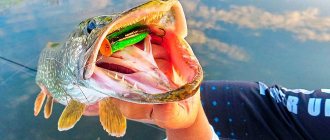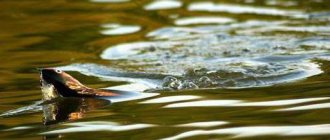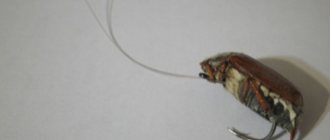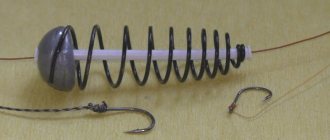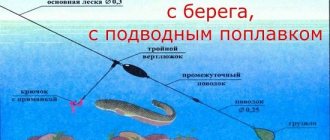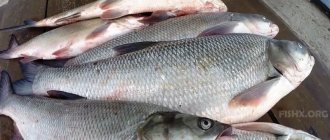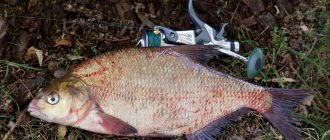Popla-popper is both a category of unique bait and a special ultralight equipment. The competent combination of already well-known poppers and micro-lures has opened up new horizons in the field of fishing with ultra-light gear near the surface.
The bait equipment in question allows you to successfully catch not only overly cautious predators in difficult areas of the reservoir, but also peaceful fish.
Benefits of the pop-popper
- Using a pop-popper and ultralight tackle, you can throw light or almost weightless baits (for example, flies) over quite long distances.
- The popla-popper is also able to attract the attention of fish with a specific “squelching” sound. Reacting to this sound, the fish swims to the place of its origin, detects the micro-bait following the float on a thin leash, and attacks.
- The pop-popper is also characterized by excellent cross-country ability, that is, it is not very afraid of the abundance of algae or water lilies. As a rule, hooks are not placed on the popper itself, and therefore it easily passes through areas with grass thickets and snags. At the same time, the hook on which the bait is fixed is so small, thin and sharp that the chance of firmly clinging to algae is minimized. Additionally, you can reduce the number of potential hooks by attaching a silicone bait according to the offset principle.
Related article: fishing with poppers

What is a popper
Popper is a bladeless surface wobbler with an elongated or slightly rounded body. Its distinctive feature is a funnel-shaped depression in the head part (“spitter”), making it look like a small fish with a wide open mouth. When retrieving, this depression creates characteristic gurgling sounds - as if a fry on the surface is grabbing insects (mosquitoes, midges) that have fallen into the water or are flying low above it.
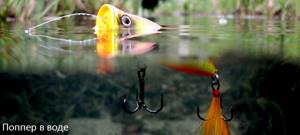
The length of this bait ranges from 3-4 to 12-15 cm, weight - from 2-3 to 18-20 grams.
The wobbler is equipped with two triple or double hooks with a soft edge. The hooks are located on wire loops-suspensions on the abdomen, in the tail part. The color of the wobbler can be either natural, like a fry of perch, rudd or roach, or bright unnatural colors (acid green, yellow). The wobbler is attached to the fishing line or the latch of the metal leash using a loop with a ring located inside its nose recess.
These fish are made from durable plastic, balsa. Most models have a sound chamber inside the body with small balls, which, when the wobbler plays, create sounds that attract predators.
On a note
When looking for the best popper, most anglers prefer hard plastic models. This material, unlike balsa wood, is stronger, more durable, and less scratched when grabbed by a predator.
Popper classification
A variety of such surface baits is classified depending on the location of the load - the shift of the center of gravity to the tail, head part of the wobbler, or its uniform distribution throughout the body of the bait.
Based on this feature, these wobblers are divided into:
- Front-loaded - most of the weight in such baits is concentrated in the head part.
- Rear-loaded - the main part of the weight is shifted to the tail of the popper.
- Lures with weights distributed evenly throughout the body.
Check the distribution of the load by lowering a popper attached to a fishing line into an aquarium or container with clear water. Based on which part of the wobbler is the most recessed, it is determined which of the types described above it belongs to.
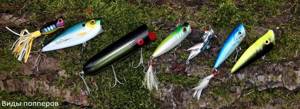
On a note
The division of these plastic fish into floating or sinking poppers is incorrect, since these bladeless wobblers do not dive deeper than 10-15 cm.
What kind of fish can be caught with a popla popper?
We have already mentioned that peaceful fish can also be caught well with the popla-popper. So, many fishermen probably already know the fact that the popla-popper perfectly catches rudd, and a little less often, perch.
In general, you can catch almost any fish that hangs around and feeds at a shallow depth (1-2 m), that is, your catch can be pike, chub, and peaceful crucian carp and roach. This encourages experimentation with micro-baits and mounting variations.

Sequencing
Let's consider two options for making a pop popper:
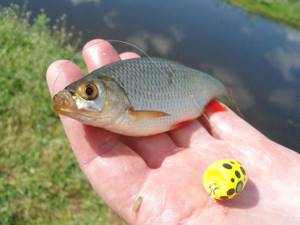
Option No. 1 (made of wood):- outline the contour on the plane of the material and saw off all excess;
- process the resulting piece of wood with a file, it is best to do it slowly, being careful not to remove too much in one fell swoop;
- give rounded outlines with sandpaper;
- drill a longitudinal hole and insert the wire there; using pliers, the ends of the wire are bent into rings;
- paint.
- Option No. 2 (from cork):
- shorten the length of the workpiece with a knife;
- place the plug on the self-tapping screw fixed in the drill chuck;
- grind the surface of the cork with sandpaper;
- finish polishing the surface with fine-grained sandpaper after the cork has the required shape;
- using a knife, make a longitudinal hole along the length of the plug and insert twisted wire into it. The length between the fastening rings should be slightly less than the length of the plug;
- paint and apply waterproof varnish.
Popla-popper vs sbirulino
The similarity between popla-popper and sbirulino (bombard) is noticeable to the naked eye. However, there are significant differences between these rigs and the fishing itself. First of all, let us pay attention to the fact that the pop-popper is an exclusively floating rig, while the bombard can be floating, sinking, or suspended.
The shape of the bombard allows it to fly further than the pop-popper, but the latter has its own unique game and is capable of making characteristic “squelching sounds” that attract fish. In other words, both the bombard and the pop-popper each have their own advantages, which is why both tackles are worth adding to your own fishing arsenal.
How to choose a popper
Catchable poppers are selected according to length, type of load, based on such criteria as the object being fished and casting distance.
To size
- With a bait size of 5-6 cm, the angler can count on catching large perch, small pike, and asp.
- For medium and large pike and asp, the most suitable baits are those with a length of more than 7 cm.
By casting distance
- If it is necessary to cast over long distances, rear-loaded baits are used.
- The best popper for short-range fishing should have a weight located at the front or evenly distributed throughout the body.
On a note
The shape of the popper affects its casting distance. Lures with an elongated body can be cast further than those with a more rounded body.

Catching rudd with a popla popper
To catch rudd on a popla popper, you must first find good places where this fish swims. These are shallow areas of a reservoir with a large amount of vegetation, as well as the so-called “windows”, surrounded by dense thickets of nettles and water lilies. Rudd is often found in shallow areas with snags.
The bite is especially good in the summer, when the water is already well warmed up and it’s hot outside. At such times, rudd stays mainly in the upper water horizon, in the shade of coastal or aquatic vegetation.
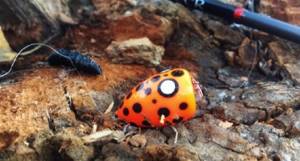
The wiring technique is as follows: cast out the rig, wait until the hook with the bait drops to the entire length of the leash, make 1-2 light jerks, during which the pop-popper makes a characteristic sound, and wait 5-10 seconds until the bait again drops to the desired depth .
Features of using bait
Of course, fishing with a popper is very exciting and is an active type of fishing. You can catch both ordinary, peaceful fish and predators.
In order for fishing to be effective, you need to select the appropriate equipment for it. The popla popper rig has its own characteristics:
- A light class rod should not be longer than 2.4 meters, even if casting will be done from the shore. With such a fishing rod it is easier to make long and accurate casts of light bait.
- It is better to take a light reel (1000 - 1500), of the inertia-free type. The sensitivity of the gear largely depends on the quality of its work.
- As the main fishing line, small diameter braided line . It is able to withstand the resistance of a large rudd or other fish, even if it goes into the reeds after hooking. A fishing line with a breaking load of up to 5.5 kg is sufficient.
- The hooks must be of high quality , designed so that grass carp may be caught and can unbend them during an active fight.
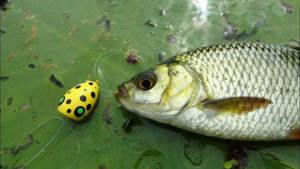
As a rule, fishing for popla popper takes place in overgrown areas of the reservoir , where they try to throw it into a clean window in the middle of vegetation or to the border between the grass and a clean area of the reservoir. An important element in attracting the attention of fish when fishing with this bait is the technique of its placement:
- if the fish is active, then the classic method of poppers , fast jerks with small pauses of 2 - 3 seconds;
- if the fish is inactive, then the pauses need to be increased , giving the fish a better look at the bait on the hook.
In addition, it has been noticed that at different times baits of different colors are more catchy:
- in early spring or late autumn, as well as on a sunny summer day, red and yellow poplar poppers work best;
- The white color attracts fish when fishing in the shade of trees or under bridges.
Another interesting feature of this equipment is that when retrieving a popper, the popper attracts fish with its sounds and splashes, and during pauses it becomes a regular float - a classic bite alarm.
DIY popper
How to make your own poplar poplar popper? In this article I will tell and show the process of making a popper at home.
An increasing number of spinning anglers prefer fishing with poppers. This bait is used mainly in fresh waters. In ponds and rivers overgrown with grass, a popper that looks like a fry will definitely attract pike or perch. This device attracts predators and significantly increases the catch, making fishing more exciting and fun.
Popper Features
Many experienced fishermen note that poppers can captivate even an inactive predator. Wiring the bait creates noise and splashes, provoking the fish to an instinctive reflex attack. The device is also supported by the fact that it rarely clings to snags and is wasted.
- Poppers are usually divided into 3 types:
- • with front loading;
- • with rear loading;
- • with average shipment.
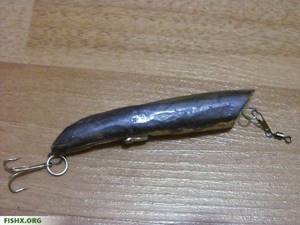
The front load provides the device with the ability to dive and move smoothly at a shallow depth, which reaches 10 cm. The rear load is needed for long casts. The working depth of such a bait is at least 40 cm. The average load contributes to a heavier flight of the popper during casting, but the device does not sink deeply, but can withstand a dive of 20 cm.
Making your own bait is not difficult. To work you will need:
- • a small block of wood (10X6X4 cm);
- • wire (for “ears”);
- • glue;
- • tee hook;
- • material for shipment (tin or lead);
- • stationery knife;
- • hacksaw for metal;
- • a piece of sandpaper;
- • pencil;
- • waterproof paints or varnish.
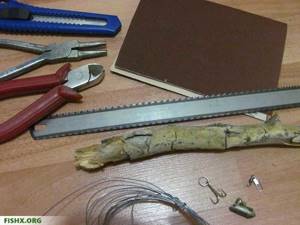
Step-by-step making of a popper
1) A wooden block (the wood must be soft) is sawn into 3 parts. From each such part you can make a separate figurine.
2) On the surface of the block you need to draw an image of the future bait. Then the specified shape is cut out from the drawing. The cut of the front working side is made oblique. For this job you will need a knife, a file and sandpaper.
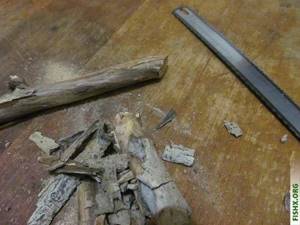
3) A correctly made workpiece is symmetrical and does not have chips.
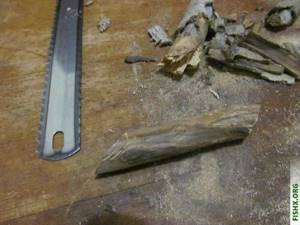
4) A central cut is made at the bottom of the workpiece. The cutting depth should not be greater than the middle of the mold. Lead will be poured into this hole.
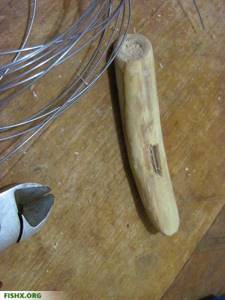
5) This popper has an oblique cut to the nose, which will ensure that it is immersed in water. In this case, it is best to place the weight at the rear of the bait. If the workpiece weighs about 2 g, a load of, for example, 0.5 g of lead will be quite enough.
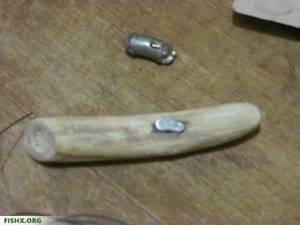
6) All that remains is to glue the “ears” made from wire. After the glue has dried, the workpiece is sanded and painted.
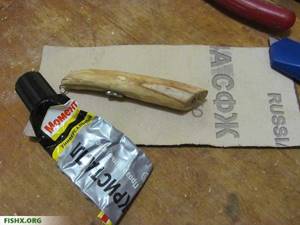
7) At the last stage, the mini popper is equipped with rings with hooks. The finished product can weigh about 4.5 g.
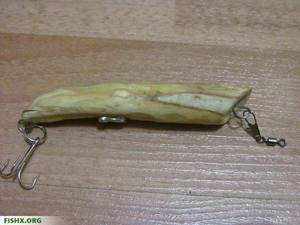
The use of a popper is relevant from June to mid-September. This feature is explained by the fact that cold weather forces the fry to descend to depth, so to attract a predator in the cold season, other types of bait will be needed.
- I recommend to read:
- The importance of hook position
- Catching pike with spoons

Source: https://fishx.org/popper-svoimi-rukami/
Homemade popper
Date: February 25, 2011 | 311
The surface bait popper has very sharply and actively burst into the arsenals of many spinning anglers. The characteristic gurgling sound and fountain of spray when jerking makes the popper very interesting when fishing in perch pots and when hunting for pike standing in grassy shallow water. It’s not uncommon for catfish to rise to the “croaking” of a popper.
Many modern wobbler manufacturers offer various poppers and other surface baits . I will not dispute the catchability of branded models.
However, such a bait as a popper is relatively easy to make yourself, from scrap materials, literally on your knees. And I have personally been convinced more than once homemade poppers Therefore, in my box there are only a few branded poppers, and the rest are homemade.
In this post I will talk about just one of the many ways to make a homemade popper . This is how I make them.
As a material, I use a dried willow stick of the required diameter. I cut out the blanks with an ordinary penknife. I flatten the sides slightly. I narrow the tail part.
I saw off the front part of the popper at an angle with a hacksaw or jigsaw. I select the cup on the nose of the popper with a well-sharpened round chisel of the appropriate number. Then, I make a cut for loading, from below along the axis of symmetry.
The popper blank is ready (Photo).
Then, the popper frame . Based on the dimensions of the bait, either only the back and front loops are made, or a third one is made under the second tee from the bottom.
The frame is glued into the cut along with a lead load.
If there are voids in the cut after installing the frame and lead, they can be filled with pieces of ordinary matches, carefully placed on the glue flush with the surface of the bait.
a homemade popper with drying oil so that if a pike gnaws through the varnish coating, the bait does not begin to take on water. We paint the surface with nitro varnish or oil paints with the addition of varnish. On top there are 1-2 more thin layers of varnish.
Regarding the colors of the poppers, this is purely my opinion: the color of the popper is for the fisherman ... The fish actually hears sounds, sees the game and a dark silhouette against the sky, as the bait moves along the surface. So, it is better to choose colors that are easily visible.
This allows you to control the popper's wiring even from a long distance. It is important. I usually paint poppers in bright, acidic, contrasting colors and combinations thereof. Small elements such as eyes, gill covers, fins and scales can be completed “for fun” with a regular alcohol marker.
And then apply the outer layers of varnish.
We hang the tees through the winding rings. The rear tee can (and sometimes even needs to) be draped with a neat fly or a short tuft of rain. The size of the tees is selected experimentally.
It happens that the lower one is slightly larger than the rear one, this often allows the popper to squish well when jerking. That's all.
If good running and sound characteristics are achieved, you can test the bait during real fishing.


